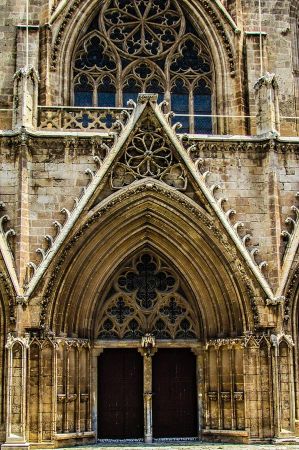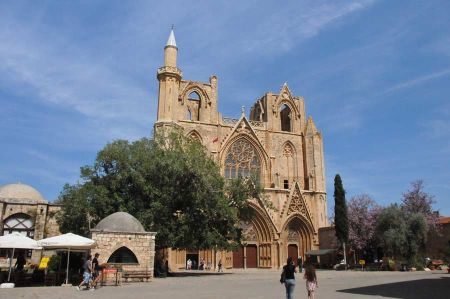The port city of Famagusta - today Gazimağusa
- Written by Portal Editor
Famagusta - Gazimağusa offers a wonderful opportunity to look and stroll in its historic old town with the ancient city fortifications, fortifications, mosques and the cathedral.
Another attraction is the harbour citadel with the Othello Tower, in which the events on which Shakespeare's drama is based are said to have taken place. Famagusta reportedly had over 365 churches, some of which still exist, some in ruins. The covered bazaar is also worth seeing.
The port city of Famagusta is a fascinating destination for holidaymakers simply because of its huge sandy beaches. In the eastern part of the beaches there are long areas of fine sand with excellent, clean opportunities for swimming.
Historical background

The fishing settlement of Ammochostos gained importance in Byzantine times when the residents of the neighbouring city of Constantia / Salamis to the north moved here after Arab raids, several earthquakes and the silting up of their port. Despite its favourable deep harbour, the place remained insignificant even under the Byzantines.
The upswing to become the richest city in the eastern Mediterranean began in the 13th century after the Frankish crusader Guido of Lusignan from the House of Lusignan, King of Jerusalem until 1192, bought the island of Cyprus from the English King Richard the Lionheart in the Third Crusade in 1192. After Guido's death in 1194, his older brother Amalrich II took over the rule. The port of Famagusta became an important Crusader bridgehead during the Third Crusade (1189–1192) due to its proximity to the Holy Land.

In Famagusta, as a cosmopolitan and tolerant city, places of worship for all major faiths were built. From 1291 to 1373, the Cathedral of St. Nicholas was built in the French Gothic style. The coronation of the Lusignans as kings of the lost Kingdom of Jerusalem and Cyprus took place here in the 14th century. In the area surrounding the cathedral, the knightly orders and the trading colonies of the Syrians, Armenians, Italians, Greeks and Jews built a large number of churches, convents and monasteries in the 14th and 15th centuries. Around 1330 the prosperity of the city and its residents reached its peak.
In the late Middle Ages the city developed into a hub for trade between Asia and the Italian port cities.
As history progressed, Famagusta declined in importance, particularly after the Ottoman conquest of Cyprus in 1571.
In 1570 the Ottoman army under General Lala Mustafa Pasha was in front of the city. After an eleven-month siege, the last 500 defenders had to surrender to superior forces on August 1, 1571. The city, which was barely damaged in the battle, was subsequently destroyed by the conquerors; churches were converted into mosques, including St. Nicholas Cathedral into the Lala Mustafa Pasha Mosque, and other churches were used as warehouses. Famagusta currently has 22 churches, but most of them are in ruins.
The city was one of the first to be occupied by Turkish forces during the Turkish invasion of Cyprus in 1974.
The old town of Famagusta played a special role in the Turkish military offensive in 1974: many Turkish Cypriots fled the surrounding area to the old town during the chaos of war and were besieged by the Cypriot National Guard for three and a half weeks. The Turkish armed forces occupied both the city of Famagusta and the tourist district of Varosia; this was declared a military exclusion zone and was intended to serve as a collateral for later negotiations.
Downtown
The former St. Nicholas Cathedral was the coronation church of the ruling Lusignan family, who were crowned kings of the then long-defunct Kingdom of Jerusalem and Cyprus here in the 14th century. The church was converted into the Lala Mustafa Paşa Mosque in 1571 and is an important example of French Gothic architecture. Opposite the mosque are the remains of the Venetian Governor's Palace.
Gazimagusa - travel report Mr. Weisenberg
In the Middle Ages, the place was one of the richest and most luxurious ports for East-West trade. In the 15th century the city also belonged to Genoa and Venice. The huge fortress was built in the 16th century under the Venetians. In the Turkish era after 1571 the place lost its importance.
We climb up to the battlements of this bastion and plan to go into the small museum below. 17 m high and circular wall. We are already admiring the curtain wall from above. We are already admiring the many Gothic remains of the Crusader churches in the middle of the small town centre. The fortress walls appear extremely powerful and seem to be able to withstand almost any onslaught of enemies. Trenches and platforms are cleverly designed to combat besiegers.
On the return trip to the old town, we reach the Othello Tower. From the attached 14th century citadel, you can see the immense defensive effort that was necessary to survive a siege. But the beauty of the halls and courtyards is also surprising. Some stone remains from the French Crusader period can still be seen. According to reports from English sailors about a despot named Moro, Shakespeare is said to have chosen this castle as the setting for his drama Othello at the beginning of the 16th century. The harmony between Moro and Mohr is telling.
The remains of a Venetian palace face the mosque. You can clearly see the stone filling and the cladding with carved stones. When a building is finished, you can no longer see the internal structure.
A highlight for us will be the Ravelin Bastion on the land side of the curtain wall. From its height you can see the defensive strategy even better: good visibility of the flanks and the besiegers and lots of thick, high walls. The bastion has many corridors and rooms whose functions can no longer be recognized today.
We would like to thank Mr Weisenberg for this travel report!
Please also read:
Lefkosa - Nicosia - still divided city
With the camper or caravan to Northern Cyprus
-
-
-
-
-
-
-
-
-
-
-
-
-
-
-
-
-
-
-
-
-
-
-
-
https://www.alaturka.info/en/cyprus/famagusta/6527-the-port-city-of-famagusta-today-gazimagusa/amp#sigProId43171a8bab
